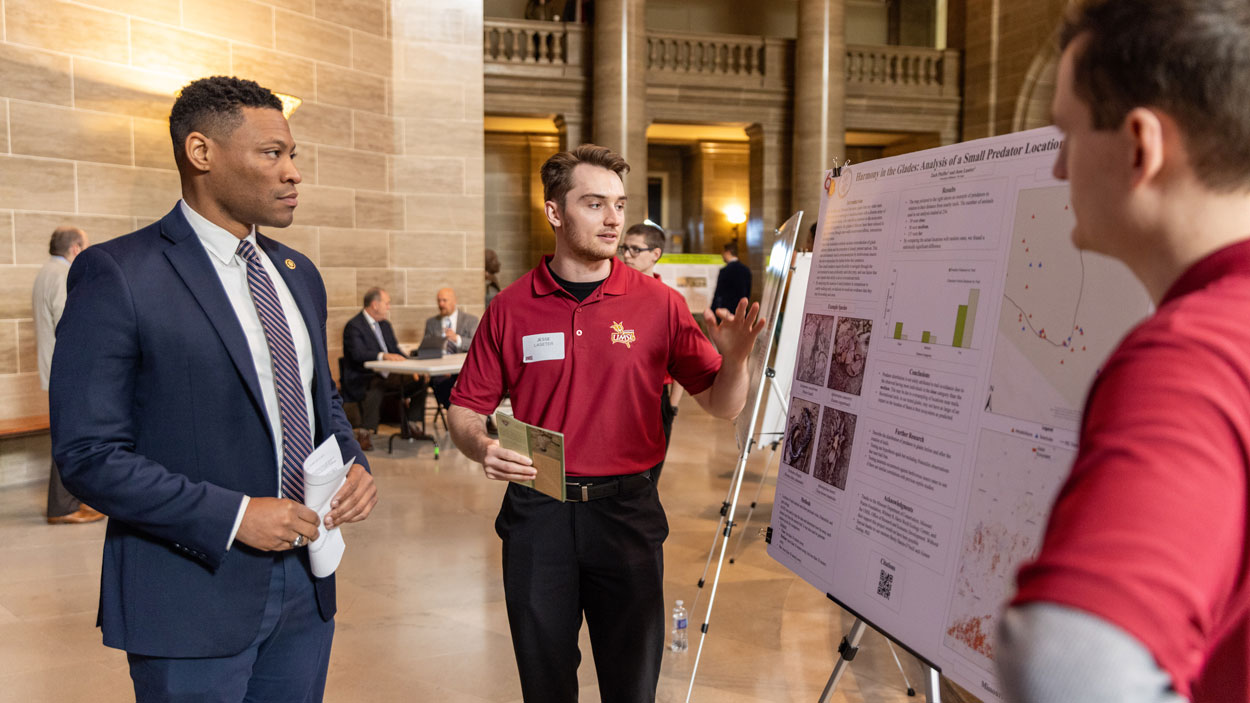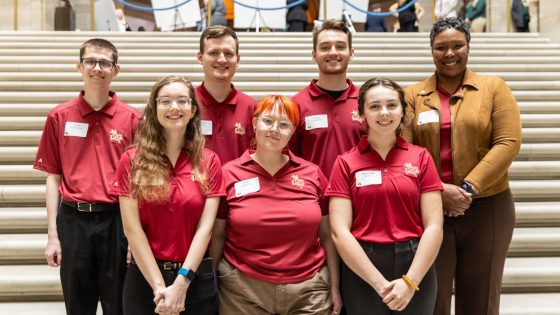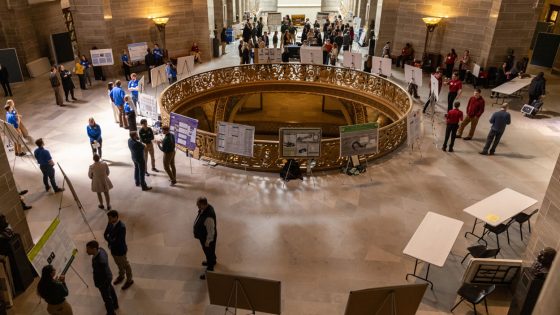
Biology student Jesse Laseter (center) speaks to State Sen. Brian Williams (at left) about his research during UM System Undergraduate Research Day at the Capitol. Laseter and fellow biology major Zachary Pfeiffer (at right) have been researching the presence of small predators in Missouri glades. (Photos by Abbie Lankitus/University of Missouri System)
Seven University of Missouri–St. Louis students joined with 36 of their peers from across the University of Missouri System in taking part in Undergraduate Research Day last Thursday at the Missouri State Capitol.

UMSL students (front row, from left) Julia Talbert, Cory Perkins and Addison Vogt and (back row, from left) John Granicke, Zachary Pfeiffer, Jesse Laseter and Brittany Bounds took part in UM System Undergraduate Research Day at the Capitol last Thursday in Jefferson City, Missouri.
The annual event was a chance for students to meet with legislators and share their research innovations from a breadth of disciplines, including biology, health, history and psychology.
“The University of Missouri System Undergraduate Research Day at the Capitol illustrates these student accomplishments and allows our elected officials to see, firsthand, the exciting innovations taking place at the University of Missouri–Columbia, University of Missouri–Kansas City, Missouri University of Science and Technology and the University of Missouri–St. Louis,” UM System President Mun Choi wrote in a letter to legislators.
As the only public research universities in the state, MU, UMKC, Missouri S&T and UMSL provide unique student opportunities to work alongside faculty members on groundbreaking research in areas that range from science to medicine to the humanities. The lessons students learn through research help prepare them for graduate and professional studies at top universities as well as careers in leading industries.
This year’s UMSL participants at the UM System Undergraduate Research Day at the Capitol were:
Brittany Bounds, nursing
Faculty mentor: Vanessa Loyd, College of Nursing
“Healthy Eating at Project Compassion”
Project Compassion is a nonprofit organization that provides resources for single mothers. Through interaction with clients, Bounds and fellow nursing students learned that the majority of meals they eat come from fast food restaurants. The project was designed to encourage the preparation of home-cooked meals. The goal was to minimize the risk factors associated with hypertension, coronary artery disease and diabetes mellitus by incorporating healthy substitutions that are sustainable.
John Granicke, economics
Faculty mentor: Rob Wilson, Pierre Laclede Honors College
“Jefferson Barracks Post Theater: A Place for People to Gather”
The Jefferson Barracks Military Post had a rich and extensive history during its 120 years as an active military installation. The Post Theater was just one aspect of everyday life at Jefferson Barracks. Granicke’s project was part of a collection of historic research blogs about Jefferson Barracks done in collaboration with St. Louis County Parks. The blogs will soon be available to view on the Jefferson Barracks County Park website. The story of the Jefferson Barracks Post Theater begins with the Old Post Theater, which was built during World War I. From 1933 to 1944, four more post theaters were built at Jefferson Barracks. They showed the latest Hollywood movies in addition to instructional military films. Soldiers and their families living at Jefferson Barracks often invited guests over for dinner and a show at the Post Theater. Numerous events and celebrations were held at the Post Theater over the years. The theater ceased operations after Jefferson Barracks was decommissioned in 1946. A few years later, the Archdiocese of St. Louis purchased the Post Theater and converted it into a church for the parish of St. Bernadette. The Post Theater building remained in continual use for over 70 years, until St. Mark Catholic Church absorbed St. Bernadette in August of 2023. Currently the former Post Theater building is used once a week for mass, but its future remains uncertain.

University of Missouri System students set up poster presentations in the third floor rotunda of the Missouri State Capitol during Undergraduate Research Day last Thursday.
Jesse Laseter and Zachary Pfeiffer, biology
Faculty mentor: Aimee Dunlap, Department of Biology
“Harmony in the Glades: Analysis of a Small Predator Location Survey”
Small predators, despite their size, play pivotal roles in ecosystem balance. Primarily, through their predation of herbivores, they indirectly benefit native plant communities. By reducing the damage from herbivory, herbaceous plants have a higher likelihood to thrive and proliferate. This is crucial in the restoration of Missouri glades. However, for small predators to achieve this, they rely heavily on their ability to navigate through their environment. One factor that may influence their ability to traverse their environment is recreational trails. Trails can cause habitat fragmentation by disconnecting one larger area into two. Trails also have significantly different microclimate than the surrounding glade and little ground cover to protect from aerial predators, possibly deterring small animals from crossing. Laseter and Pfeiffer’s hypothesis posited that by looking at the locations of the herpetofauna and tarantulas found in Missouri glades, in comparison to nearby walking trails, they would see evidence that they might be avoiding such areas.
Cory Perkins, psychology
Faculty mentor: Hannah White, Department of Psychological Sciences
“Deconstructing Diagnostic Criteria for ADHD”
Attention-Deficit/Hyperactivity Disorder, or ADHD, is a highly prevalent disorder across development. Early detection is a critical first step to early intervention but the average age of diagnosis is 7. The Diagnostic and Statistical Manual of Mental Disorders, Fifth Edition, includes 18 symptoms for ADHD. The purpose of this project was to determine how these 18 symptoms individually map onto effortful control, surgency, and negative affect (measured via the Child Behavior Questionnaire) in 3-6 year olds. A better understanding of how ADHD symptoms manifest in that age range has the potential to move the average age of diagnosis and help connect children with resources earlier.
Julia Talbert, biology
Faculty mentor: Bethany Zolman, Department of Biology
“Investigating the Impact of Edaphobacter aggregans (WBG1) on Arabidopsis thaliana Development”
Acidobacteria is a phylum of bacteria that make up 50% of soil microbes. While making up a large proportion of bacteria found in soil, this phylum is largely unexplored with limited information about the bacteria and their impact on plant growth. The selected target of this study was Edaphobacter aggregans, WBG-1, which is a part of a subdivision of acidobacteria. Examining the bacteria’s effects on the development of the model plant Arabidopsis thaliana could provide insight into understanding this unknown phylum of soil-dwelling bacteria. Acidobacteria are an important realm to investigate as they affect agriculture practices. With Missouri being such a hotspot of farming, it is important to know the function of what is in the soil.
Addison Vogt, psychology
Faculty mentor: Hannah White, Department of Psychological Sciences
“Effects of Written and ScreenBased Media on Infant Attentional Control”
Vogt’s study investigated how exposure to both television and book media impacts infant executive function, as assessed through attentional control. Specifically, eye-tracking was used to examine infants’ average fixation duration as an index of how efficiently they divide their attention in a visual scene. A sample of 44 3½-month-old infants participated in a social cognition eye-tracking study, where they viewed static images of human bodies. Results indicated the more hours per week parents reported reading to their infants, the stronger attentional control infants demonstrated by showing lower fixation durations. The number of hours infants were reported to watch television per week, however, did not predict attentional control. The current study suggests being read to may promote executive function in infants as young as 3½ months, providing further evidence parents should read to their infants early and often, and suggesting reading time may be a useful target for intervention and prevention studies aimed to promote robust cognitive development.














